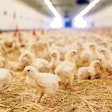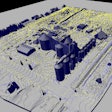Feed mills of all sizes have long benefitted from the efficiencies offered by automated palletizing systems, yet many whom have not adopted the technology may be unaware of how far robotic systems have evolved in the last decade.
“I think some consumers still have the mindset that robots are too complex, but now 99% of the time any issues can be resolved with a phone call,” says Phil Wright of Icon Robotics, an integrator and manufacturer of palletizing and packaging systems, a division of JMP Engineering. In the past, automated systems may have required staff engineers to program, maintain and work with robots; however, advances in technology have made systems user-friendly, with simplified interfaces and easy to program configurations.
The tendency for businesses to first consider introducing automated systems to address the most difficult and least forgiving portions of their business, Wright believes, may not be prepared for complications that come with complex machinery implementations.
“This is a mistake for the first system because you’re really going to strain everyone,” Wright explains. “We often say take baby steps – choose a system that’s easy to automate and will deliver the greatest return.”
Automated palletizing systems are one of the more basic implementation to deliver major gains in cost savings, worker safety and productivity — not to mention an attractive return on investment.
To discuss their experiences with implementing automated systems, Feed & Grain spoke with three feed mills of various sizes to get their feedback on a number of key areas and to offer advice to peers who may be on the fence over investing in these technologies.
INCREASED OUTPUT, LABOR SAVINGS
For Kerr Feed and Grain, a small feed supplier and one-stop shop retail outfit in rural Henrietta, TX, the primary goals of the investment were to prevent injury and eliminate the man-hours it took to physically stack its feed.
Kerr purchased a Chantland-MHS system with a Fuji robot. Prior to making the investment in the system, workflow went like this: one employee hung bags, one did the sewing, two stacked the feed and another drove the forklift. Today, all manual lifting has been eliminated and three employees work the line.
Wade Bryant, general manager and representative of the fourth generation of Kerr Feed and Grain, explains how bags now move through the packaging portion of the mill: “A bag enters on one of two lines and hangs on the bagging scales to be filled until it meets the requisite weight and is dropped onto a flat conveyor standing vertically. After it is sewn, Chantland’s knockdown-turner conveyor, a belt that pulls the end out from under so it lays flat, before moving it to the bag flattener to even out the product. The prepped feedbags move to a pick-up conveyor where the Fuji robot places bags on one of two stacking stations. [The robot] loads one side until the pallet has reached the determined load amount. Once that side is complete, the forklift driver removes the full pallet and resets the station. The robot moves to the other stacking station and alternates back and forth.”
Kerr Feed and Grain’s new system stacks 60 tons of bagged feed/day at full capacity; the company produced 15,000 tons of grain, annually.
AUTOMATION EXPANDS OPPORTUNITY
While popular sentiment among employees is that robotics equate to job loss, in actuality, companies tend to retain the operators and reassign them elsewhere within the company.
“[Employees see us walk in and they are worried they will loose their job, but typically it’s the opposite,” Wright says. “The companies that don’t automate are the ones who end up downsizing. The more efficient the plant, the more profitable it becomes and it keeps growing because they can keep their costs down.”
As was the case of Otter Cooperative’s feed manufacturing division, Otter Feeds in Aldersgrove, British Columbia, before it invested in its American-Newlong automated palletizing system, employees in the feed mill manually staged and stacked 44-pound bags on pallets before a forklift operator moved the full pallets to shrink wrapper. At that time, it was moving about 65 tons/day, running two eight-hour shifts with one dedicated stacking employee working each shift.
“In theory, we eliminated 2.5 bodies/day,” says Vafa Alizadeh, Otter Feeds feed division’s operations manager. “We didn’t lay anybody off we moved them around to do other tasks because between then and now we have picked up more business and have been able to offer better customer service.”
In addition liability insurance costs tend to drop with robotic systems, as there are less workers compensation claims by reducing the risk of lifting injuries. “By eliminating lifting we have less claims and fewer missed work days and obviously our rates are better now,” Vafa says.
“[Worker’s comp savings] factors into any hard numbers you can recuperate from any investment like this,” Bryant explains.
NO SPACE TOO SMALL
Today, feed mills shopping around for packing solutions are especially sensitive to potential space constraints their facility may face; manufacturers have developed solutions to meet these challenges. Many suppliers have the ability to change the design to suit the customer.
“Customers what a system to consume the smallest footprint possible,” say Wright. “Space is valuable and companies aren’t looking to build new sites or expand facilities because times are tight so the goal is to do it within the existing plant.”
Typically, as bagged product moves through a facility, small space makes it difficult to accumulate product, a critical portion of product flow. If there is any glitch in the system or replenishment of consumables, the system will go down for a bit and, without accommodations for accumulation, everything behind it goes down. While most systems have sufficient accumulation on conveyors to allow the robot or automated equipment to continuously run without having to wait, but extensive conveyors systems rob the mill of floor space.
Working outside of the box, for example, the engineers of Icon Robotics introduced vertical accumulation to combat the constraints of limited space.
“By accumulating vertically form the top or the bottom, now we are taking up very little floor space rather than stretching across the plant,” Wright explains.
Otter Feeds faced its own unique challenges when considering the layout of its palletizing system. The initial thought was to automate the entire system, but after realizing that based on the height of the bins above the bagger it didn’t have room for an automatic system of putting bags on the shoot after the scale, Vafa says. Otter’s options were raise the bins or in dig down and install everything in a pit.
Vafa describes the solution: “Otter Feeds purchased an American-Newlong fully automated bag packaging and palletizing equipment. We decided to leave bagging section of project as is because we had the accuracy of the scale and realized that no matter how much equipment we installed it would need one operator to monitor this whole system. The operator puts empty bags on the bagger, fills them up and sends thorough sewing machine and applies the label at the same time. The bag then travels on a conveyor to a flattener to get the air out and through a tear drop, to distribute the product on the bottom of the bag before it goes to another conveyor at the staging station. The robot picks it up from there and turns it 90 degrees and onto a ready to pallet form the pallet dispenser with a piece of cardboard then it releases to station and a top film is applied and one to a turntable shrink wrapping system and applies it and to another conveyor with has room for two ready to go pallets.”
Otter Feeds’ system was completely installed in May 2010; it paid of the system in 1.5 years, a year less than it had anticipated.
“It’s been a great investment for us and we’ve seen great results from it,” says Vafa.
TRAINING AND CONSISTENT RESULTS
With proper training, operators have a chance to become familiar with the robots and the programs so by the time the company plans for its next more complex system, it will be easier to implement with a lessened learning curve. Hubbard Feed, the feed manufacturing division of Ridley, Columbia/Okura automated systems since 2004, and has installing two to four a year since 2008 in the company's 12 feed mills in various application.
"The [Columbia/Okura] operating system is easy-to-use and consistent makes it easy to transition the equipment between plants, easy for start-ups and for any employee to understand," explains Dustin Varvil, director of manufacturing, Hubbard Feeds, a division of Ridley Inc. A typical system is set up like this: The feed goes into an automated packaging scale where it is weighed and dumped into a bag; then it is hand feed into sewing machine. Once the bag is laid on to the conveyor, it is delivered to the robotic system where it goes over a tear-drop conveyor to even the feed out in the bag. The bag makes it was over rollers where the robot picks it up and place it on a wood or plastic pallet. At full capacity, the robotic system stacks 14 bags/minute.
Varvil urges not underestimate the importance of training and crosstraining employees. "As the xxx, you spend so much time investigating the equipment and getting the equipment in place, so it's easy to get caught up and forget that I have to leave and these other employees are the ones who have to run it everyday. These systems can be intimidating to a farm boy who doesn't want to break the system. Don't underestimate the amount of training they may need.We invest enough money so that employees are comfortable with it before the tech leaves, and that's where success lies."
MAINTENANCE, WHAT MAINTENANCE?
According to the equipment manufacturers and the end-users interviewed, palletizing systems very rarely is it a mechanical problem that will require a service call – unless operator error or the machine has been used for a long time.
“Some machines run for two years without maintenance — which is different than it was 15 years ago,” says Wright, Icon Robotics. “The first U.S. system we put in 1998 is still running today. Some companies may want to overhaul every decade, but the life expectancy is unknown. Maybe at the 20-year mark you would need to evaluate if you want to upgrade or you could swap it out, but it’s not uncommon for any robot to run 10 to 15 years without any reason to change it out.”
Bryant, Kerr Feed & Grain, admits he was originally hesitant about the mechanical and electronic side of things, dealing with a computer because it has a PLC inside the tower that operated the mechanics inside of it, but his concerns have been proven unfounded.
“I would suggest anyone set their worries aside because what we’ve seen and from what we’ve heard they are well built pieces of equipment with very little downtime,” Bryant says. He anticipates the ROI in three to five years.
Vafa concludes: “Not a cost saving thing, but an investment for a better future."


















